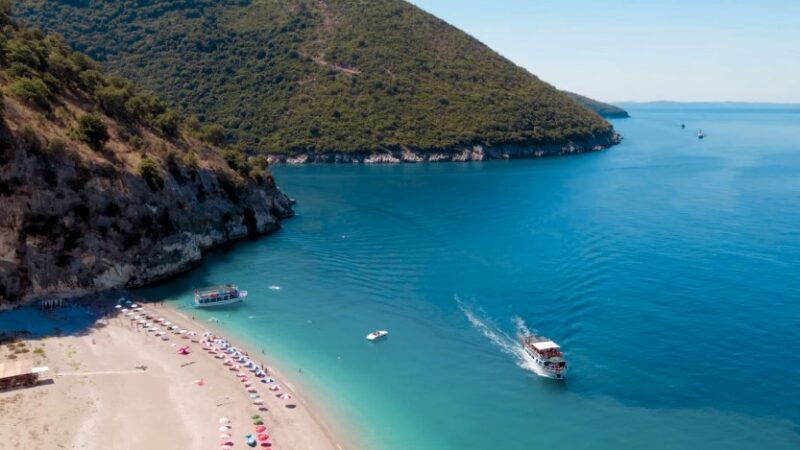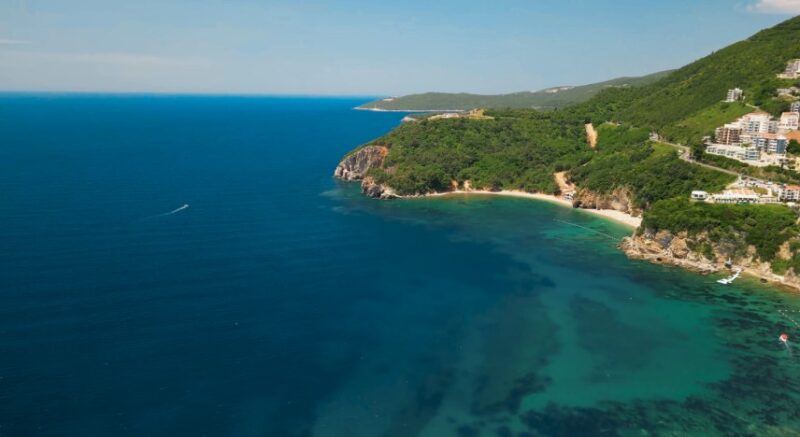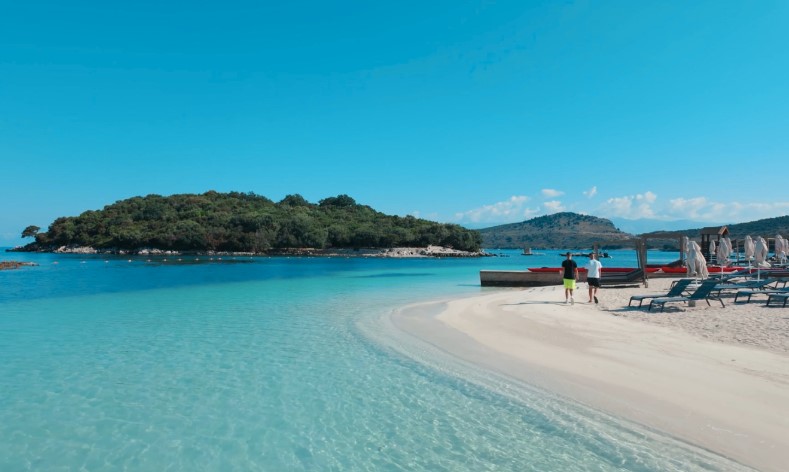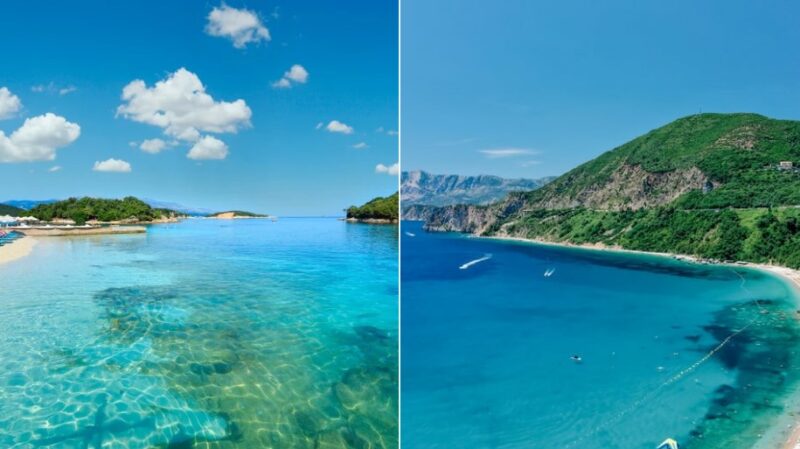The Balkans aren’t exactly a secret anymore. More travelers are catching on to the region’s charm, especially when it comes to its coastlines.
But if you’re trying to pick between Albania and Montenegro for a 2025 beach escape, you’re not alone. Both are heating up fast – Albania’s tourism bookings have doubled, and Montenegro’s are right behind.
Still, the vibe, experience, and even the price tag can be quite different depending on where you plant your beach towel.
Let’s walk through what each coastline brings to the table, and help you figure out which one actually fits your travel style in 2025.
A Quick Look
Albania’s Coastline

Albania’s got range. With 476 km of coastline that touches both the Adriatic and Ionian Seas, it’s almost twice as long as Montenegro’s – and that extra room makes a difference.
The Terrain and Feel
Up north near Velipoja, you’ll find sandy, shallow beaches along the Adriatic. As you head south into the Albanian Riviera, the coastline starts to get dramatic. Think steep hills, stone villages, and beaches tucked between cliffs.
The Ionian side is where the real magic happens – crystal-clear water, rocky shores, and fewer crowds. What stands out is the rawness of it all. Albania doesn’t feel curated.
You get rough roads, small cafes with homemade raki, and beaches that haven’t been bulldozed for hotels. If you’re into nature, exploration, or just want to avoid tourist traps, it hits the mark.
Beach Highlights
- Saranda: The biggest coastal hub. You’ll find bars, decent restaurants, and easy access to Ksamil or Butrint. It’s lively but not exactly luxurious.
- Dhërmi: Classic postcard views – turquoise water, white stones, hills dotted with olive trees. Great in shoulder season, but packed in July and August.
- Borsh Beach: Seven kilometers of sand with barely a hotel in sight. A gem for anyone who wants space and quiet.
Adventure Over Amenities
Albania isn’t trying to impress you with champagne service. Facilities can be basic, and luxury is still rare outside major hubs.
But if you’re okay with that, you’ll get a lot in return. Canyoning, hiking, wild camping, and local hospitality are all part of the deal. Plus, you can still find beachfront meals for under $10.
What’s Changing in 2025
Tourism is booming. In just five years, visitor numbers doubled – from 5.1 million to over 10 million. With that kind of surge, the coastline is starting to feel it.
The north is being hit hardest: coastal erosion is swallowing land in Velipoja and Kune, with the sea creeping in by up to 20 meters a year. More than 30 hectares of forest and wetland have vanished in Velipoja Park alone.
Construction is also ramping up. Golem, once a sleepy beach town, is now stacked with apartment blocks and hotels. Meanwhile, a proposal to build 600+ villas inside Butrint National Park has environmentalists on high alert.
The government’s “Touristic Albania 2030” plan is trying to walk the line – reserving public beach space while also fueling development – but it’s a tricky balance.
Why Albania Might Be Your Pick
- It’s Cheap: Albania is around 26% more affordable than Montenegro, according to Expatistan. Accommodation, meals, transport – you name it, it’ll cost less.
- It Feels Real: You’re not getting a manufactured experience. It’s locals running guesthouses, cooking meals, and helping with directions.
- There’s Still Room to Roam: Even with the growing crowds, places like Borsh or Qeparo feel wide open.
- The Trends Are Real: It’s the #1 trending coastal destination for 2025 for a reason. But if you want to enjoy it before things get too polished, now’s the time.
Montenegro’s Coastline

Montenegro plays a different game. It doesn’t have the length (just under 300 km), but it packs a lot into that stretch. If Albania feels like an open sketchbook, Montenegro is more like a finished painting – clean, detailed, and curated.
The Landscape and Vibe
Montenegro’s coastline is carved into coves, cliffs, and little bays. The jewel in the crown is the Bay of Kotor, a fjord-like inlet that winds deep into the mountains. It’s a UNESCO site and looks almost unreal.
Resorts are fancier. The beaches have chairs and umbrellas lined up by mid-morning. You’ll still find quiet corners, but overall, Montenegro feels more designed for vacationers, including those who are on a hush trip.
Top Spots to Know
- Kotor: Walled town, cobbled alleys, towering mountains all around. One of the most atmospheric places on the Adriatic.
- Budva: Party central in summer, with a medieval core and long beachfronts.
- Ulcinj: Velika Plaža here is one of the longest beaches on the Adriatic – flat, sandy, and still underdeveloped for now.
- Petrovac: Relaxed and family-friendly. Good for a slower pace.
- Dobrec Beach: Only reachable by boat. Great for an escape, with seafood shacks right on the water.
Comfort Is King
Montenegro’s infrastructure is solid. Most places have ATMs, decent mobile coverage, and easy transit between towns. You don’t need a car – buses and boats cover most routes.
If you want to sip a cocktail on a yacht, check into a spa hotel, or book a paddleboard tour last-minute, it’s all doable.
What’s in Flux for 2025
A development proposal for Velika Plaža has stirred up debate. The plan, backed by UAE investors, would pour billions into luxury resorts and real estate on one of Montenegro’s last untouched stretches.
Critics call it rushed, opaque, and potentially devastating for the area’s delicate ecosystem, which supports half the country’s bird species and connects to Albania’s Bojana delta.
President Milatović returned the law to parliament, halting the deal for now, but the future’s still uncertain. If the project moves forward, it could change the character of the area drastically.
Why Montenegro Might Be Right for You
- It’s Easy: Transportation is smooth, and towns are tourist-ready.
- It’s Diverse: Beaches, nightlife, old towns, mountain drives – you can do a lot in a short time.
- It’s Luxe-Friendly: From Porto Montenegro to boutique hotels in Kotor, you can lean into comfort.
- It’s Growing, But Still Manageable: Bookings are up 98%, but it’s still quieter than places like Croatia or Greece.
Tips for a Smart 2025 Trip

Albania
- Travel Window: Late May to early July or September to avoid crowds and heat.
- Getting Around: Rent a car, especially for reaching quieter beaches like Borsh.
- Stay Options: Family-run guesthouses, beach huts, and campsites. Book early in Saranda.
- Eco Choice: Avoid Golem, choose less trafficked spots like Qeparo or Palasa.
Montenegro
- Best Timing: Same as Albania – spring or fall for fewer crowds.
- Getting Around: Buses are frequent. A bus from Budva to Kotor takes 30 minutes and costs about $5.
- Where to Stay: Budget in Ulcinj, mid-range in Budva, luxury in Porto Montenegro.
- Eco Pick: Visit Velika Plaža while it’s still natural. Support nature-based tours around Ulcinj Salina.
Still Can’t Decide? Combine Both
One of the best moves in 2025 might be to skip the either-or question and see both. Start in Tivat or Podgorica, swing through Kotor and Budva, then drive or take a transfer down to Albania through the Muriqan border.
A week split between the two countries offers an unbeatable contrast in pace and personality. It’s the kind of trip you’ll brag about for years – especially before mass tourism catches up.
Final Thoughts
Both coastlines are having a moment in 2025. Albania feels like a raw gem that’s still shaping its edges, while Montenegro is ready-made for comfort and convenience.
One gives you nature without the filter, the other hands you a cocktail at sunset. Go where your gut pulls you. But don’t wait too long – these coastlines are getting crowded for a reason.

